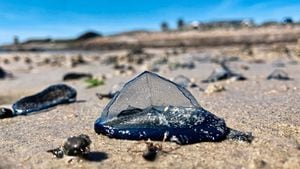By-the-wind-sailors are blown up on island’s shores
A thin blue line of small jellyfish-like creatures decorated the west coast yesterday, as winds brought thousands of oceanic visitors to Guernseys beaches.

Known as by-the-wind-sailors, because of their characteristic sail, the creatures, only a few centimetres long, could be found all the way from Rocquaine Bay to Chouet.
The animals are not true jellyfish, but rather are a colonial hydroid, similar to the Portuguese man o’war, made up of a colony of tiny individual animals.
Local marine biologist Richard Lord said they were often found in large numbers on local beaches.
‘They are harmless but intriguing animal,’ he said.
‘We often see them, but it is a little unusual to have them at this time of year as they normally get blown ashore in the autumn.’
By-the-wind-sailors, also known as Velella, typically live far offshore in open waters.
The sail allows the organism to catch the wind and travel on ocean currents, using its stinging tentacles to prey on young fish and other small animals.
However they are totally at the mercy of the winds and so are usually found washed up in their hundreds, or even thousands, after stormy weather.
The direction of the sail along the float determines which way the by-the-wind-sailor will travel.
If the sail runs north-west to south-east along the float it will drift left of the wind direction, if the sail runs south-west to north-east it will drift right of the wind direction.
Mr Lord studied in California and said that the numbers locally were nothing compared to there.
‘Like the jellyfish they are related to, they can have years of abundance where there numbers soar,’ he said.
‘They turn up in such huge numbers in California they can turn the beaches blue.’





